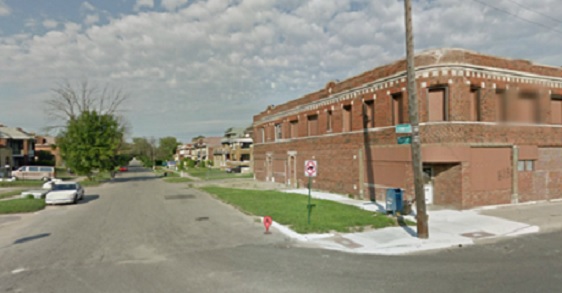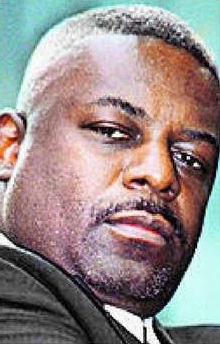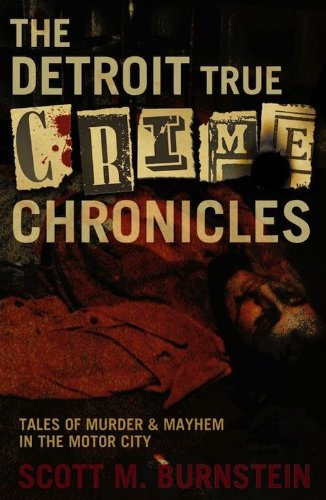 Sprouting up in the late 1970s on the city’s West Side around the areas surrounding Dexter, Monterey and Linwood Avenues, Young Boys, Inc. started out as a small group of loosely connected drug dealers sharing a common supply source and soon was on its way to becoming a mega narcotics empire that operated with assembly-line efficiency and expert criminal acumen. YBI, as the group became known, completely changed the drug game in Detroit. The organization was a pioneer in underworld marketing and sales strategy, and in just five years it would erupt as a notorious part of the city’s historical fabric while becoming its most financially successful narcotics ganger ever. Authorities estimated that the gang cleared close to half a billion dollars cash in the1982 calendar year alone.
Sprouting up in the late 1970s on the city’s West Side around the areas surrounding Dexter, Monterey and Linwood Avenues, Young Boys, Inc. started out as a small group of loosely connected drug dealers sharing a common supply source and soon was on its way to becoming a mega narcotics empire that operated with assembly-line efficiency and expert criminal acumen. YBI, as the group became known, completely changed the drug game in Detroit. The organization was a pioneer in underworld marketing and sales strategy, and in just five years it would erupt as a notorious part of the city’s historical fabric while becoming its most financially successful narcotics ganger ever. Authorities estimated that the gang cleared close to half a billion dollars cash in the1982 calendar year alone.
“YBI was the first real iconic criminal organization to emerge out of the city since the old Purple Gang of the Prohibition era,” Carl Taylor has pointed out. “They crafted the mold for all who came after them in the game. They were the model of how a well-run, large-scale narcotics gang operated. The emergence of YBI changed everything and really opened up a Pandora’s Box of activity that hasn’t stopped to this day.”
The first traces of the gang emerged around 1976 when aspiring kingpins Raymond “Baby Ray” Peoples, Dwayne “Wonderful Wayne” Davis and Mark “Block” Marshall brought their individual crews together and started selling heroin out of a bar on the corner of Prairie and Puritan. When Milton “Butch” Jones, a close friend of both Block and Baby Ray, was released from prison in February 1978, after serving a four-year sentence for manslaughter stemming from a robbery in late 1973, and joined up with the fast-growing operation, YBI was officially off and running. The four YBI founders were a good mix. They complemented each other well. While Peoples and Davis were more of the hustler type, master movers and shakers, Jones and Marshall were straight thugs, heartless street soldiers with itchy trigger fingers. In his autobiography, which he self-published in 1996, Butch Jones admitted carrying out his first of many murders when he was only 15 years old.
It’s alleged that seed money for the gang’s first large-scale narcotics purchase came from an $80,000 insurance settlement that Mark Marshall received when his father was killed. Collecting the money was no easy task, since Marshall himself was conspicuously charged with a heinous crime: the mass murder of three people and a dog whose corpses were all ejaculated on. Although he wound up being tried twice for the triple homicide, Block was never convicted and subsequently was able to collect the insurance payout. Although he was the last man on the scene, Butch Jones quickly ascended to the top of the gang’s leadership and immediately imposed his will on the direction the syndicate would take. He was a natural bully and not a person who liked to share power.
 “Butch Jones was pretty menacing guy,” Robert De Fauw remembers. “He bullied his way to the top of the gang and once he was there he ruled with overwhelming force. He and his crew were just coldhearted, ruthless people. I know one of his favorite enforcement tactics was to beat his enemies with a baseball bat. He did a lot of damage and hurt a lot of people.”
“Butch Jones was pretty menacing guy,” Robert De Fauw remembers. “He bullied his way to the top of the gang and once he was there he ruled with overwhelming force. He and his crew were just coldhearted, ruthless people. I know one of his favorite enforcement tactics was to beat his enemies with a baseball bat. He did a lot of damage and hurt a lot of people.”
Intent on building YBI in the mold of a Fortune 500 corporation, Jones cultivated an infrastructure that was highly organized from top to bottom. Trying to diversify the gang’s activities as much as possible, he split the operation into several distinct street factions, each responsible for a different aspect of the syndicate’s overall bottom line. At the top of the food chain were Butch and Block, who ran their own individual army called “The Wrecking Crew” and oversaw the day-to-day affairs of the entire organization. Baby Ray and Wonderful Wayne, who went by the alias “WW”, were each given responsibility over individual crews and operated with general autonomy, deferring to Jones only for basic policy decisions and mediation of intra-gang disputes. Beneath the founders was an enforcement crew known as “The A Team” and led by teenage hit man Curtis “Kurt McGurk” Napier as well as a finance and supply crew led by Sylvester “Seal” Murray. Within Wonderful Wayne’s faction were separate subfactions, jointly overseen by Davis and Jones that dealt specifically with the cutting and marketing of the drugs. These master mixers cooked up enticingly potent brands of heroin and slapped on their packaging slick and catchy names like “Atomic Dog,” “Purple Haze,” “Hocus Pocus,” “Starlight,” “Whippersnapper,” “Rolls Royce,” “Hoochie Con,” and Jones’ own personal concoction dubbed “Check Mate” in honor of his love of the game of chess.
Butch was never one to abide by the status quo, so he also made sure that YBI was the first gang of its era not to have to rely on the Mafia for its drugs. Said to have been enamored with the city’s original “Black Godfather,” Henry Marzette, the area’s first dealer to oppose the mob’s control of the marketplace, Jones patterned his legacy after him. So it was only natural when he got out of jail and hooked up with Baby Ray, Block and WW – who were all being supplied by Italian-backed sources – that he steered them away from relying on the Mafia for their product and encouraged complete independence. Jones and the fledgling Young Boys found that independence when they secured former Marzette lieutenant John “Milwaukee Jack” Mayes as their first primary heroin supplier. Mayes would soon introduce Jones to his protégé Seal Murray, who would go on to become Butch’s top advisor and main conduit to the wholesale drug community outside of Michigan. Even further down the ranks, making up perhaps the most integral cogs in the entire organizations, were the teams of street dealers, all boys and girls between the ages of 8 and 12, that sold the product on their elementary school playgrounds and delivered it on 10-speed bicycles and in taxi cabs paid for by their superiors. These juveniles were the same ones who did most of the gang’s marketing footwork, plastering the city’s various housing projects with handwritten coupons and notices of sales and new product development.
When the gang reached its peak of power in 1981, it controlled a staggering 90 percent of the drug trafficking taking place within the city limits. The epidemic of young children dealing on behalf of YBI became so ingrained in neighborhood culture in the late 1970s and early 1980s that little girls jumping rope would sing out rhythmic cadences like “Starlight, Hoochie Con, Rolls Royce round and round” among other rhymes that reference the narcotics their peers were selling at the time.
“They were history makers all right,” said De Fauw. “By the end of YBI’s run, they had reshaped the way the drug game was played on both sides of the law. We had to adjust our methods as law enforcement, up our game if you will, to get an accurate beat on these guys. They were the first gang to start really exploiting preadolescent kids to their advantage and using them as shields. It made things a much more delicate process on our end in terms of investigating them.”
YBI gang members tended to travel in bulk. When members showed up at a nightclub or concert, they were often 50 deep. Usually dressing in unison, they sported the trendiest clothes and styles of the era. One day they would all be wearing red Adidas tracksuits and white Adidas Top 10 running shoes, the next, brown and green military fatigues and steel-toed boots. During winter the gang favored fur-lined Max Julian hooded jackets, and they were known to wear “John Dillinger derbys” – Styrofoam political campaign hats adorned with red, white and blue stripes around the brim. Modes of transportation were of the utmost importance as well. And as with their clothes, members of YBI were notorious for purchasing in lockstep. Two dozen or more Mercedes and Corvettes were bought at the same time and then promptly shown off during massive caravans to places like Cedar Point or King’s Island amusement parks in Ohio or sporting events and concerts in locations within a day’s driving distance.
Dissatisfied with living in the city where they grew up and plied their trade to great riches, Butch and Baby Ray hightailed it to the plushy suburbs as soon as they could. Both relocated in ritzy Oakland County, with Butch moving to Oak Park to a house he built with an indoor pool and Baby Ray moving further north to Troy where he purchased a three-story residence in a leafy and secluded, newly developed subdivision.
“I knew the second I laid eyes on these guys we were dealing with a different breed,” said Carl Taylor, who spent time working in the private security business. “It was an eerie feeling that came over me because I immediately realized how much destruction a group like this could do. These cats were young, but so sophisticated and organized. They had an aura unlike any group like them I had encountered before. The neighborhood kids all gravitated to them. There was a prestige on the streets when you were affiliated with the Young Boys. It was like saying you played with the L.A. Lakers or New York Yankees.
The good times lasted a half-decade, from roughly 1977 to 1982. And then the common perils of the industry started to set in and the gang self-destructed. The core of YBI, which consisted of about 50 people, was torn apart at eh seams by greed, jealousy and resentment. Like a circling shark that smelled blood in the water, the government came in and delivered the deathblow, levying back-to-back-to-back federal indictments that spelled complete decimation for the gang by 1987. It was an ugly dismantling process.
 This is an excerpt from The Detroit True Crime Chronicles. Available at www.Amazon.com
This is an excerpt from The Detroit True Crime Chronicles. Available at www.Amazon.com



11 Comments
Was edward lee walkins a member of ybi he’s going around saying he was just wondering if it’s true
Edward Lee Jackson, thats my cousin………we were born and raised on Martindale and Elmhurst right across from where Raymond Peeples and Butch Jones lived…
Who cares he yo cousin
I LIVED ON MONTEREY & PETOSKEY FROM 1977-1985
I WENT TO BIRNEY ELEMENTARY AND WINTERHALTER
ON BROADSTREET MY PARENTS MOVED US TO ALABAMA
IN 1985 I WASENT A MEMBER BUT I WITNESSED THE Y.B.I.
Lets make sure we do not claim to be part of or witness to anything concerning the YBI.
Was there a guy by the name of sincere Lucas…. not sure what his Alisa would have been…. it’s weird cuz he says he was never caught by police the entire time he was involved
What you gone do if someone does ???
Nigga what you gone do
No matter how many times you fail, you must face life and be full of hope
I went 2 winterhalter my brother star Green half of 14 they called him 7 they used 2 play Baseball in our back yard with my brother on Dexter & Waverly in their glasshell shoes W goldfish & Dice in their sade & leather Glasshell shoes it wuz WW, young Earl, Barney aka Bone man, punkin aka Bushrod, Frankie D, Tyrone, Baby Ray,These were The Original yBIs and I know mose of or some of their Documentrys because my older brother raned with them guys back in the late 1976 & early 1977. My name is lil Dave
I grew up on Puritan near Greenfield and went to Crary Elementary. Saw these guys as I was growing up and knew they were all tight but not that they were affiliated. My dad was a banker/account manager at 1st Independence and was asked by YBI members if he was interested in doubling his salary by managing their books. They were straight up about it and did not hide who they were. He said he’d pass and they went about their business. later we moved to Rosedale Park a short distance from where we started but it felt like a million miles to me. I graduated from Redford HS in 1988 hard to believe that I grew up in the middle of the action and never really knew. I work for NASA now and live in Florida, but for a few turns, my life could have been completely different.